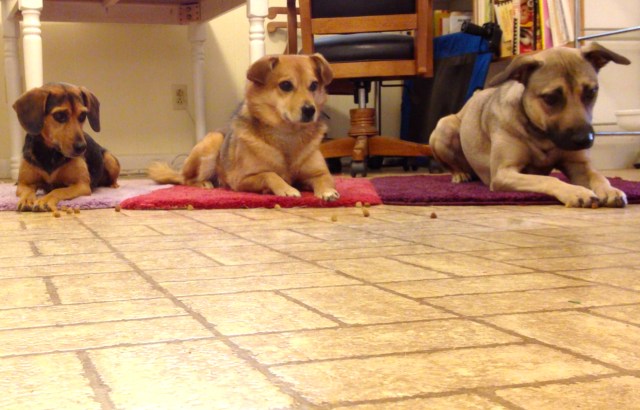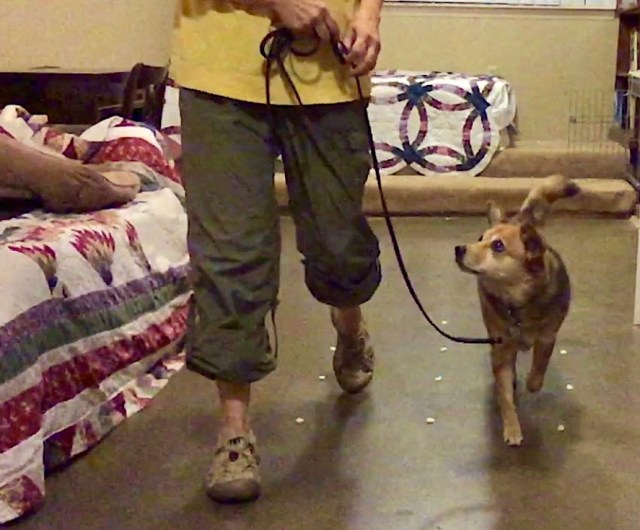Barks Blog
Leave It: Not Just for Dead Men Anymore
The other day I was pondering the trend of talking about teaching “self-control” and “impulse control” in our dogs. I got to thinking about “leave it,” both the term and the behavior. I realized a couple things. First, the term “leave it” doesn’t pass the dead-man test. (I’ll get to that below.) Second, the behavior “leave it” is not just one, but several behaviors. Third, I realized that this combination of problems could present some difficulties when training.
What is your dog actually doing when she successfully “leaves it”?
You know what that means: I’m going to write about it!
Negative vs. Positive Descriptions
When describing how we would like dogs to act, how many times do we start with the word “doesn’t”? (Or worse, “shouldn’t.”)
- The dog doesn’t counter-surf.
- The dog doesn’t jump on people.
- The dog doesn’t bark inappropriately.
- The dog doesn’t pee or poop in the house.
You get the picture. And as people with a little (or a lot) of experience with positive reinforcement based training, you know what good trainers will do first. They will decide–and describe–what they want the dog to do. Like this:
- The dog lies on a mat when in the kitchen.
- The dog keeps four feet on the floor for greeting.
- The dog barks once and runs to a family member when the doorbell rings.
- The dog eliminates outside.
I could have made the second group of descriptions more specific and precise. You can consider them a rough draft. But with the descriptions I was taking the first steps toward something called operationalization.
Operationalization and Dead Men
Operationalization is an important concept in applied behavior analysis. To operationalize a behavior is to describe it in observable, measurable, objective, and specific ways. (That description is from this article about behavioral interventions with children, but most definitions are similar.) For some reason that is difficult for humans to do. We want to conceptualize and label things instead. The dog is being naughty; the dog is being dominant; the dog is getting back at us; the dog is acting guilty.
None of these phrases tells us what the dog is actually doing. And if we are going to observe, analyze and modify behavior, we have to know that.
When you operationalize behavior, you can’t define it as a negative or an absence of something. Attempting to define a behavior by what it isn’t fails the “dead-man test.” Ogden Lindsley coined this term in 1965 and you can read about it here: From Technical Jargon to Plain English for Application.1)
The bottom line is that if a dead man can do it, it’s not a behavior. Look at my top list of problem dog “behaviors.” A dead man could do all those things. For instance, dead men are really good at things like “not counter-surfing” and “not jumping on people.”
Attempts at behavioral descriptions that start with the word “doesn’t” usually aren’t real behaviors at all. They fail the dead-man test.
The dead-man test comes in handy because it clues you in to times when you are going down the wrong road. For instance, when discussing negative reinforcement, I have had people tell me that all other behaviors besides the one that’s being negatively reinforced are automatically being punished. For instance, let’s say I have dirty hands. I wash them. My hands are now pleasantly clean and washing was negatively reinforced. Having dirty hands was aversive to me and I removed that aversive via washing. But my correspondent wrote that also, “not washing hands” was positively punished.
Whoa! What does “not washing hands” look like? Ask a dead man. He’s doing it right now. If there is no behavior observed and described, we can’t identify punishment occurring. (By the way, there could have been positive punishment in this scenario. But there’s not enough information in my description to know.)
Exploring “Leave It”
And that brings me to “leave it.” We tend to think of “leave it” as being a single behavior. We casually define it as the dog not getting that thing that we don’t want it to get. But wait! “Not getting the goodie”? That doesn’t pass the dead-man test.
When we talk about “leave it,” we actually may be talking about one of several behaviors. Watch this video of baby Clara learning “leave it” (a.k.a. Zen in Sue Ailsby’s Training Levels.) She does great, despite some poorly timed markers on my part. But what behavior is she learning?
[youtube https://www.youtube.com/watch?v=Zdpn8GwHtaw?feature=oembed]
Link to the puppy video for email subscribers.
When we teach Zen or “leave it,” we usually mark and reinforce the first thing the dog does after she stops mugging and licking the hand. So I marked (late, but it worked) when Clara pulled her head back. I then dropped the treat, and she got it off the floor. The very next time around, Clara pulled her head away and looked at the floor. Clever pup. And that’s the behavior I reinforced for most of the rest of the session.
So at that time, Clara’s experience with “leave it” was:
- When a fist with a treat inside it appears in front of your face…
- look at the floor…
- and a treat will appear.
She also learned that licking or even approaching the hand with the treat in it didn’t work. Those behaviors started to extinguish in that context.
Here are three more examples of “leave it.”
What are my dogs doing in this picture?
If I operationalize it, I would say that they are lying on their mats with their heads up, watching treats roll by. I could improve on the term “leave it” by calling this behavior a down stay or a mat stay with distractions. 2)
What is Summer doing in this picture? (Those are pieces of mozzarella cheese on the floor.)
Summer is walking with me on leash, keeping her head and shoulders in line with my left side and within two feet of me such that the leash stays loose. She is doing this with a major distraction of cheese on the floor. AKA “leave it.”
Finally, what does Clara do in this movie?
[youtube https://www.youtube.com/watch?v=1Pq-oVBKDuw?feature=oembed]
Link to the Clara recall video for email subscribers.
When I call her, Clara lifts her head up from the food she was eating, turns, and runs to me. It’s a challenging recall. But it’s also “leave it.”
Can we specify that “leave it” consists of one of these four things?
- Come
- Stay
- Continue another duration behavior
- Relax the jaw muscles to release an item
Did I miss anything?
So What? (Part 1)
Sometimes we can train ourselves into a corner if we don’t operationalize what the dog is actually doing. Clara learned (after the above puppy video) that a reliable way to get a reinforcer in a “leave it” situation was to move away from the tempting item. She put distance between the item and herself. This worked fine until I started using food as a distraction on the floor and she actually had to go close to the food to do what I was asking of her. Then I realized that I had taught “leave it” as “back away” when what I really wanted was “hold your head up and keep your mouth closed.” Those are pretty different!
I wrote a whole post about that: The Missed Cue: Attack of the Zen Field.
The embedded movie in that post shows Clara struggling when I ask her to get on her mat with a treat in the way. This was harder for her to learn than it was for my other dogs. That was probably because backing away from the treat had been so heavily reinforced.
Anybody want to suggest how I could have made the transition with less stress for her?
So What? (Part 2)
This post started off as a rant prompted by the use of the terms “self-control” and “impulse control” in the dog community. I have used those terms myself, plenty of times. That’s how we conceptualize what we want from our dogs. We don’t want to have to order them around all the time. We would like for them to perform the behaviors we like almost automatically (with reinforcement from us, of course).
But I am becoming a little concerned about using the constructs of “self-control” or “impulse control.” They have an almost moralistic edge to them. The typical definitions of those things for humans involve urges, emotions, and morality. More important, we tend to see self-control type behaviors all under one big umbrella. I think that with our dogs we do better to talk about specific behaviors. Just as we shy away from using constructs such as “guilt” in dogs because of the harm that can be done under that assumption, I think we might want to hesitate in using these general terms about self-control. We don’t know that the dog conceives it that way. What we do know is that we can successfully reinforce certain behaviors.
I truncated my rant when I found out that the term “self-control” does have a valid definition for animals. It’s a big topic, so I’ll address that in the future.
In the meantime, here is my encouragement to operationalize, operationalize, operationalize! Figure out specifically what you want the dog to do. Figure what it looks like. Define it. Describe it. Then teach it.
And for fun: does your dog do anything quirky as part of “leave it”? I bet there are some cute ones out there.
Related Posts
- The Missed Cue: Attack of the Zen Field
- Zen Generalization: Hole in the Fence
- Dog Faming: Zen on the Move
Related Movies
Copyright Eileen Anderson 2016



